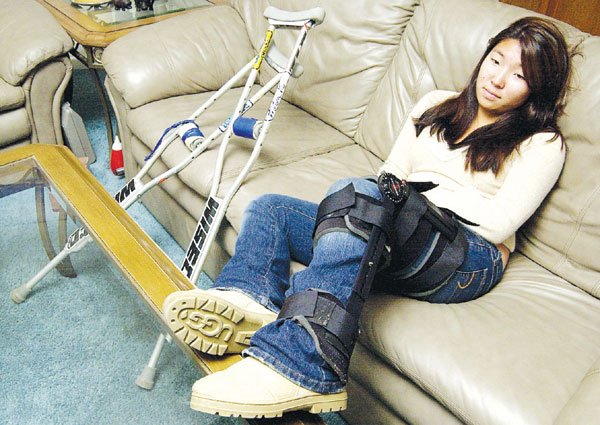ACL injuries are on the rise in the United States. Studies
indicate that women, particularly teenage girls, are far more
susceptible to damaging this balance-related ligament than men
– suffering as many as four times the number of injuries per
capita of male athletes in high-risk sports like basketball and
soccer. And with growing numbers of girls in sports, the rates
continue to climb.
ACL injuries are on the rise in the United States. Studies indicate that women, particularly teenage girls, are far more susceptible to damaging this balance-related ligament than men – suffering as many as four times the number of injuries per capita of male athletes in high-risk sports like basketball and soccer. And with growing numbers of girls in sports, the rates continue to climb.
“A lot of girls mess up their ACLs in soccer,” said Iwanga. “I know probably five just from around here.”
Female soccer players are at the greatest risk, according to the site WebMD.com, and their ranks in the United States are among the most quickly growing of any sport. Seven million girls play on organized teams, and what causes this potential for injury is subject to debate.
The typical methods of injury form a short list: Jumping, cutting, deceleration and direct blows, but the underlying reason is obscured. While most men face injury from direct blows in the course of sporting events, women self-injure based on the way they move, said Dr. Barry Tuch, an orthopedic surgeon in Gilroy.
“There’s a difference in the way men and women jump,” said Tuch. “Women tend to land on flat feet with their knees straighter, while men seem to land in a more crouched position. When they’re cutting from side to side, women tend to plant their feet and move with their bodies. Men tend to stay lower, so they use their hips and their knees more.”
Tuch believes that muscle makeup may also play a key role in determining the number of ACL injuries he sees – more than half of his surgical patients for ACL reconstruction are women, a nearly four-fold increase since he started in the business 25 years ago.
“Women have a disproportionally large percentage of quadriceps muscle versus the hamstring, which is stronger in men,” said Tuch.
This observation is supported by findings from the American Academy of Orthopedic Surgeons, which listed overdevelopment of the quads as a prime reason for ACL injury in a 1999 report. The quadriceps are the muscles of the leg which pull the shin forward, extending it, while hamstrings pull the shin back. Overdeveloped quads bring the shin too far forward, loosening the ACL.
But Anna Marie Lewellen, a physical therapist at Hollister Physical Therapy, disagrees with the argument.
“I think that would be an overgeneralization to say that the hamstrings and the quads were out of balance,” she said. “It would completely depend on the sport they’re doing.
A girl that’s doing volleyball
is going to have huge hamstrings and can still get injured. For knee injuries, it’s would be more about an imbalance in
the frame.”
While boys continue to grow mostly vertically through the end of development, girls’ bodies undergo some major changes starting around the beginning of high school. In lay terms the process is generally referred to as “filling out,” but the source of more womanly curves isn’t just about gaining padding in a few key spots. Structurally, the female pelvis begins to widen during adolescence, changing the alignment of bones from the hip down.
“The shape of the bones is not necessarily changing,” said Lewellen. “It’s just that the way they fit together is going to be different, which will change the line of pull on where the muscles attach.”
This is the reason, said Lewellen, that many high school-aged girls appear knock-kneed. The imbalance in the pelvis forces the knees in, strengthening the muscles of the outer thigh while leaving the inner thigh underdeveloped.
“That changes their balance, but once girls stop growing around 16 or 17, they learn that new balance and it’s less of a problem,” said Lewellen. “While they’re young and they don’t have that, to be playing in sports and competing is something … that leaves them very vulnerable. Their brain and their body aren’t always connected.”
Two other injury sources are less common, but important to be aware of, said Tom Giles, a physical therapist at the Morgan Hill Physical Therapy Center. Girls tend to have looser joints than boys, a boon when it comes to sports that require flexibility like gymnastics and dance, but a potential disaster in more jarring physical contact situations. Likewise, a girl’s shoes can be the real menace.
“It’s always a good idea to get their feet looked at if there’s pain,” said Giles. “A lot of times these newer athletic shoes increase performance, but they also increase the chance for injury because they grip so much better.
“The ankles need to be looked at, too, to make sure that pronation – the word we use for things being lined up right – is correct. That’s a common area for a problem and it might be better with a custom orthopedic.”
For Iwanga it’s too late to take preventative measures.
“It hurts,” she said. “I hate it. I can’t really walk normally still.”
Iwanga still faces six more months of physical therapy, including electrode stimulation to help her build muscles she can’t feel.
“My leg is still numb,” she said. “It’s kind of hard to shave, but I don’t have to wear the brace at school anymore.”
Doctors say Iwanga might be able to go back
to her favorite sports, golf and soccer, after the physical therapy is complete in April of next year.















